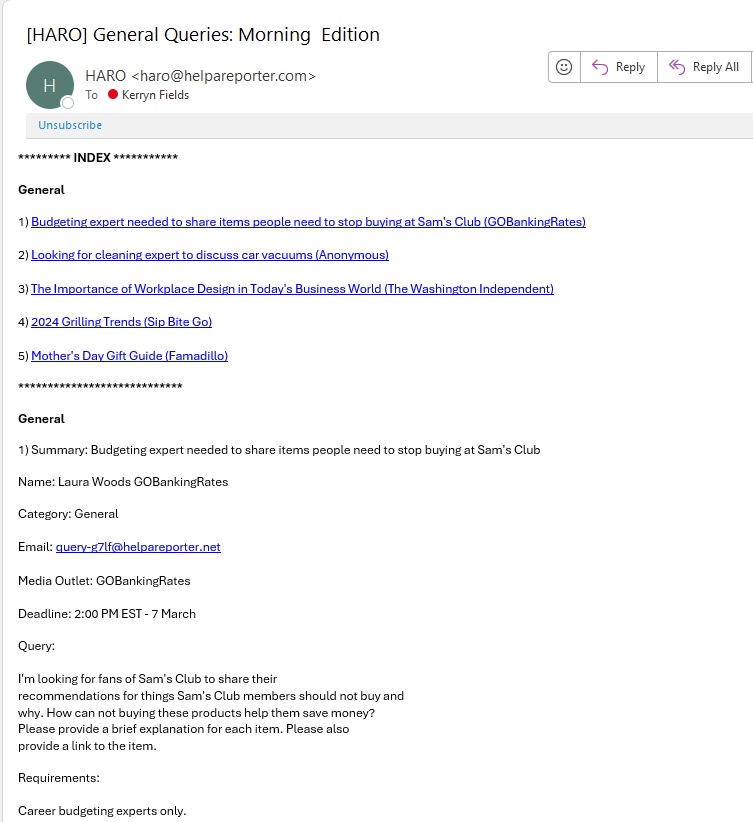Read the latest blogs here to learn something new, hear about latest industry trends or research, or simply be entertained! If anything strikes a cord, get in touch, I'd love to hear from you.

How to use HARO to secure press coverage
“Life opens up opportunities to you, and you either take them or you stay afraid of taking them.” Jim Carrey
What is HARO?
HARO stands for Help a Reporter Out and is a valuable, free online service that helps connects experts and journalists – a bit like a matchmaking service. Journalists, podcasters and bloggers use it to ask for experts to comment or provide advice for articles they’re working on and experts get the chance to pitch themselves for these. Imagine it as a giant bulletin board where they (the journalists etc) post requests for information, and experts (like you) can respond.
Here’s how it works:
Journalists and Bloggers use HARO to gather information from people who know stuff (that’s you) for their upcoming stories. For example, they’re a magazine for CEO’s writing about the rise of wellbeing in the workplace. So they post on HARO looking for wellbeing in the workplace experts to comment.
Sources (Experts): You, as the expert, sign up as a source on HARO and then will be emailed with the opportunities for media coverage made by the journalist. When you see the post, you reply directly to the journalist with your best pitch explaining why you’re best suited to answer and then give them the answers in the same email. The journalist can then decide which expert(s) to use in their article.
HARO sends out email queries three times a day (at 5:35 a.m., 12:35 p.m., and 5:35 p.m. Eastern time) and you can choose which ones you want to receive and which categories you want to hear about.

Here are some tips for using HARO and pitching the journalists to make sure you increase your chances of being picked:
1. Answer immediately – the journalists will receive loads of responses so will generally go with the first few they receive that give them what they need.
2. Only answer if you’re an exact fit for their query e.g. if they’ve asked for a back specialist to answer, don’t answer if you are a GP with no specialist knowledge in backs.
3. Answer their query exactly. The requests are usually very specific about what they need information on so give them what they’ve asked for and no less.
4. Do not reply by asking them what they want from you e.g. “I’m an expert, what do you need from me” or “What would you like to know?”. Another expert would have replied with their advice and answered the request so the journalist will go with them and they’ll delete yours because you’ve not done what they asked and are wasting their time.
5. Give them two clear and succinct paragraphs, make them grammatically correct and make sure the spelling is right too! One paragraph should explain why you’re credible to answer their query and the other should include your advice as well as at least two interesting quotes. Make all of it engaging and quotable and you’ll have more chance of being included!
6. Copy and paste your website url for the webpage you want to direct the audience to in the body of your email as the hyperlinks don’t always get through the HARO system.
7. If the publication is anonymous, don’t ask them who it’s for – give them what they need and don’t answer them with a question. They will delete your email – they’re too busy!
8. Do not include attachments - you can copy and paste assets into the body of the email though.
9. Give them your social profile url’s and how many followers/ subscribers etc you have. Mention that if you’re included, you’ll happily share the article with your network and audience. If they know this, it might help as some of their performance measurement is based on how many readers/ listeners they get.
10. Do not pitch after the deadline finishes. End of.
11. ALWAYS say thank you if they use you in their coverage and share the article/ podcast episode like you said you would - and tag them in it too.
12. Use this interaction to build relationships with the journalists for future pitching opportunities.
Good luck and remember to put 10mins in your diary everyday to focus on growing your visibility. Things don't happen if you don't schedule time for them
If you're ready to get press coverage, or are working towards it but not quite ready yet, I have a range of offers available to help you boost your credibility and visibility using the power of publicity or to get on your way.
Book a call to find out how I can help you.
Subscribe to my newsletter and be the first to hear about
new offers, resources and discounts!
